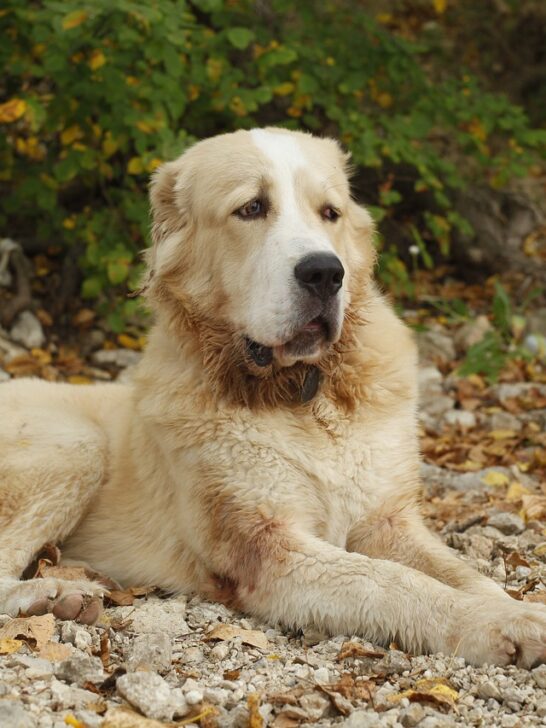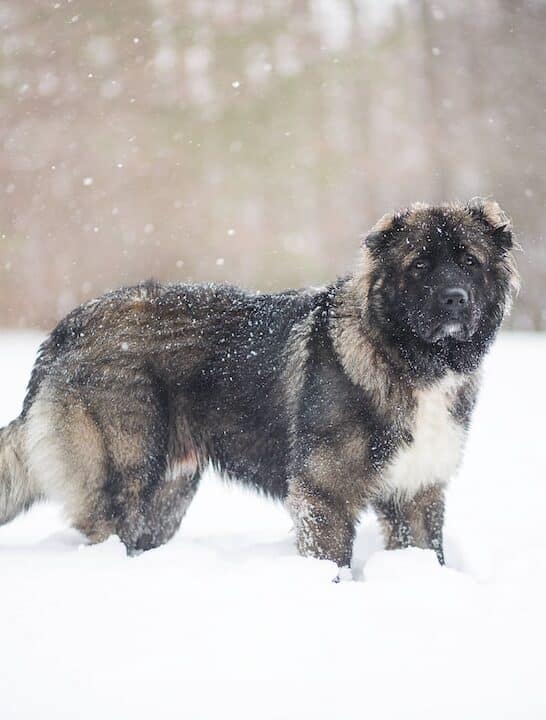German Shepherd Corgi Mix: Why Is The Corman Shepherd An Excellent Family Dog?
Some breeds seem to have no obvious reason for us to mix. When you hear of a Corgi German Shepherd mix or Dachshund mix, you might automatically assume it is a bizarre accident or experiment.
Would it shock you to find out that the Corgi German Shepherd mix is a designer dog? Breeders commonly seek to reproduce such a mix for growing customer demand.
A Corman Shepherd, as she is sometimes called, is a hybrid of the German Shepherd and one of the two types of Welsh Corgis.
Their mutual history of herding sheep means the Corgi and the GSD have many qualities in common.
As you might imagine, the Corgi German Shepherd cross usually resembles a German Shepherd on shortened legs with erect ears, a bright, intelligent expression, and plenty of energy.
The hybrid is loyal and generally friendly, making an ideal family dog in many ways.

German Shepherd Corgi Mix: Breed History
German Shepherd
Both the German Shepherd and Welsh Corgi originated to herd livestock in Europe and have their native countries attached to their names.
An ex-cavalry captain developed the German Shepherd around 1899 from a show dog named Hektor and herding stock from across Germany.
Max Stephanitz formulated the breed standard for the GSD around the traits that would best suit a working dog.
The dog’s function was far more important in the original German Shepherd than his appearance.
Although a large part of Shepherd’s striking good looks relates to her resemblance to a wolf, Stephanitz strove to create readily apparent differences.
According to Diffen.com and other sources, wolves have longer narrower skulls than the Shepherd, smaller eyes, and larger paws and teeth.
German Shepherds are usually about three inches shorter than wolves and smaller but with broader chests and higher cheekbones.
Thuringian Shepherds, like Horand, stamped German Shepherds with their wolf-like appearance. Surprisingly, these dogs were not easy to train.
Dogs from the Wurttemberg region brought trainability, size, and stamina, and those from the Swabian areas a strong work ethic, versatility, and a great capacity to assist people.
Corgi
Out of the two Corgi types, the Cardigan Welsh Corgi came first. The breed developed in Wales as early as 3,000 years ago with ancestors in common with the Dachshund.
Celtics brought the first representatives of the Cardigan Welsh Corgi to Wales from the central part of Europe. Early Cardigans may have been a mix between working Dachshund and Spitz family lines.
The Pembroke Welsh Corgi sprang up about 1,000 years ago with the influx of more spitz-type dogs with whom Corgi owners again outcrossed their dogs.
Dogs of the Spitz family only became widespread in specific areas of Wales, resulting in two distinct types of Corgis.
Great Britain grouped the two Corgi types as one breed until 1934, resulting in blurred lines at shows and ready crossbreeding between the Pembroke and Cardigan Welsh Corgis.
Even as some Corgi families became intermixed, judges displayed favoritism at dog shows for one type or the other, leading to inconsistent and hotly contested champions.
Britain finally officially separated the breeds in 1934.
Cardigan Welsh Corgis remain rare compared to their Pembroke cousins, although gaining ground in the United States.
Britons have placed Corgis on the Endangered Native Breed List for dogs with under 300 registered new pups in a year, according to Business Insider.
Cardigans are slightly larger than Pembroke Welsh Corgis and longer in the body. They have relatively larger heads, and they lack the gene for a naturally occurring bobtail.
They do not add significant differences from Pembroke to the outcome of a German Shepherd Corgi mating.
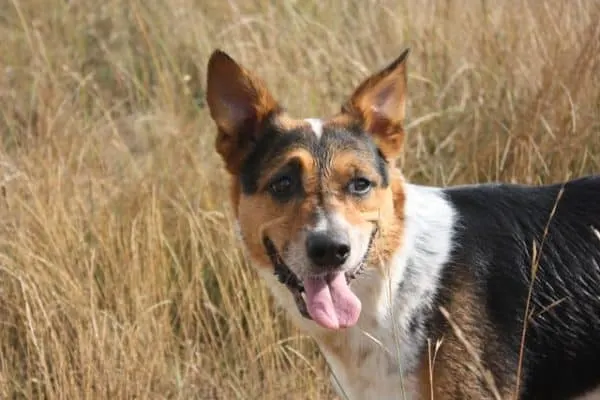
Where Did The German Shepherd Corgi Mix Originate?
The origins of the German Shepherd Corgi are unclear. Designer breed popularity peaked in the 1990s when the Labradoodle was conceived but does
Some hybrids are accidental, but many are “designed” for specific purposes, whether to help modify certain health issues, reduce aggressive tendencies, enhance watchdog potential, or lessen detrimental exaggerated features.
Although not known for certain, the Corgi German Shepherd mix probably originated with the desire to add dwarfism to German Shepherds, so they looked more charming and to instill some bubbliness to their personalities.
Secondary goals may have included adding size and height to the Corgi to make her a more effective watchdog and adding unique color variations to both breeds.
The ultimate wish was likely an appealing family-oriented companion.
Corman Shepherd hybrids most often involve the Pembroke variety of Corgi, probably because of their much greater popularity and more widespread availability.
Enthusiasts agree that the Corman Shepherd is a relatively new designer dog.
Nevertheless, the German Shepherd Corgi cross, according to Thehappypuppysite.com, is the No. 4 most popular combination for either parent breed.
How Big Will Your Corgi German Shepherd Mix Be?
German Shepherds are usually medium-large dogs. Females are 22 to 24 inches tall at the shoulder while males are anywhere from 23 to 26 inches in height.
Shepherds weigh from 55 to 95 pounds, with some individuals slightly over 100 pounds.
Pembroke Welsh Corgis, on the other hand, are small, ranging from 10 to 12 inches at the shoulder and weighing 24 to 28 pounds.
Males are noticeably taller and heavier than females. At 10 to 13 inches, Cardigan Welsh Corgis are not much taller than Pembrokes, but they can weigh 25 to 38 pounds.
Like many small dog large dog German Shepherd hybrids, the Corgi has a great deal of influence over height while the GSD contributes quite a bit to the weight range of the Corman.
Petgearlab.com reports hybrids to stand about 12 to 15 inches tall and weigh from 25 to 70 pounds.
German Shepherd Corgi Mix Appearance
Your Corgi German Shepherd mix will have a bright and intelligent expression.
German Shepherds and Corgis have similar heads.
A German Shepherd has a characteristic slightly domed forehead with a long and somewhat narrow snout, although they lack the fine-boned structure of some other breeds.
The Shepherd’s ears are large and open with definite points at the tips.
A Corgi has a more definite slope to his forehead. He, like the Shepherd, has rather large ears, but they are rounder. His eyes are also rounder and larger, and his snout shorter relative to his size.
Where the German Shepherd looks like a wolf in the face, the Welsh Corgi resembles a fox.
Your German Shepherd Corgi mix may look like one or the other breed in the head, but a balanced blend will create a dog with a muzzle medium in length with tight lips, rather round dark eyes, a moderately domed forehead, and large erect ears that may be rounder than a Shepherd’s.
Her gaze will be steady but open and curious.
A Corman Shepherd Cross May Look Like A Small GSD Or Overgrown Corgi
A German Shepherd Corgi will most likely have a German Shepherd body on shortened legs. The Corgi’s stubby legs are dominant traits.
A GSD hybrid will appear long in the torso, but his legs will not be quite as short as a Corgi’s.
His face will be a little smaller than a pure Shepherd’s but longer than a Corgi’s. His eyes will probably be rounder than a Shepherd’s but with a slight and exotic slant and dark pigmentation.
His ears will be large and probably less pointed than a Shepherd’s.
You can often see the power in a German Shepherd Corgi mix with a rather long and substantial neck. The tail is long and bushy.
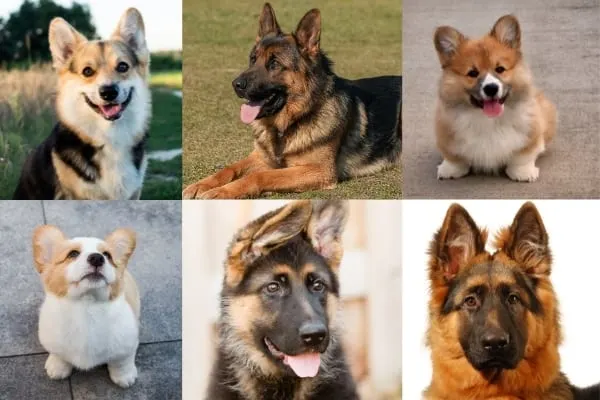
What Colors Can Your Corgi German Shepherd Mix Be?
German Shepherd
- Black and tan
- Red and tan – more common in European show lines
- White – disqualified except at White Shepherd shows
- Liver – fault
- Blue
- Panda – White covers 30% of the dog’s body. Panda naturally occurs in purebred German Shepherds, albeit rarely.
- Black
- Sable – In the agouti color family, agouti is a blend of shades of red, brown, and gray seen in many wild animals such as deer, wolves, and weasels.
Pembroke Welsh Corgi
- Black-headed or red-headed tricolor
- Sable
- Fawn – often a lighter shade of red and no black facial mask is present
- Red with white
- Black and tan
- Brindle and merle are unacceptable colors indicating mixed heritage according to the Pembroke Welsh Corgi Club of America.
Cardigan Welsh Corgi
Most dogs have white trim in stereotypical patterns (neck, chest, legs or feet, and a blaze on the face).
- Black
- Black with brindle or tan points
- Sable
- Red
- Blue merle – Blue merle is black and gray in swirls, and dogs with this coloration may have one or both blue eyes.
German Shepherd-Corgi
- Black and tan
- Golden, red, and brown
- Tricolor
- Sable
Corman Shepherd Temperament
Although it is difficult to predict temperament in hybrid dogs, you can safely assume your GSD Welsh Corgi mix will inherit courage, boldness, fearlessness, loyalty, and a strong work ethic from both parent breeds.
Moreover, the mix is protective and a tireless worker.
The Herding Group Has Different Working Styles
Watching dogs in motion is always captivating, and the herding class is no exception.
While sheep and cattle herding by dogs are not nearly as prevalent as they once were, the skills are still highly respected, as evidenced by trials to test a dog’s proficiency.
One feature you can immediately observe is that breeds herd using different styles.
Heelers
Some dogs, like Australian Blue Heelers, have their style of herding in their names. Others like the Corgi are also heelers, nipping the ankles of livestock to move them along.
Heeling was commonly associated with herding or driving cattle and other livestock to market. Other drovers, or dogs used to drive livestock, were Old English Sheepdogs.
As small as they are, Welsh Corgis have prowess with cattle and yet lack skills for sheep. Their short legs made them so low to the ground that Corgis can stay underneath a flying bovine hoof.
Moreover, Corgis were extremely agile, traits they still possess.
Tenders
Herding dogs like German Shepherds keep herds, typically of sheep, in designated grazing areas.
They run a physical or an imaginary barrier, keeping the animals away from dangerous territory, crops, and roadways. German Shepherds were also called boundary patrol herders.
Headers
Border Collies move herds from the front instead of the back like the Corgi. They use strong eye contact and assume various often low-crouching positions that resemble the behavior of predators to sheep.
The strong eye works better on sheep than cattle for headers. Flock handlers call headers gatherers because they round up stragglers.
Corgis also have a strong eye, but they direct their gaze towards the animal’s heels.
Some herders, like Australian Koolies, use a combination of heeling and heading and may even run over the backs of sheep.
Others, like the New Zealand Huntaway, use their voices because they originated from high grasslands with obstructed visibility.
Corgi German Shepherd Mix
A Corgi German Shepherd mix will likely be able to engage in a few types of herding, similar to the Shepherd.
Although originally finding use as tenders, you can train German Shepherds and mixes to be headers.
A German Shepherd Corgi mix can develop a medium eye like a Shepherd, which enables them to maintain intermittent and thereby nonthreatening eye contact with livestock.
A heading dog is useful for present herding trials that place a premium on Border Collies.
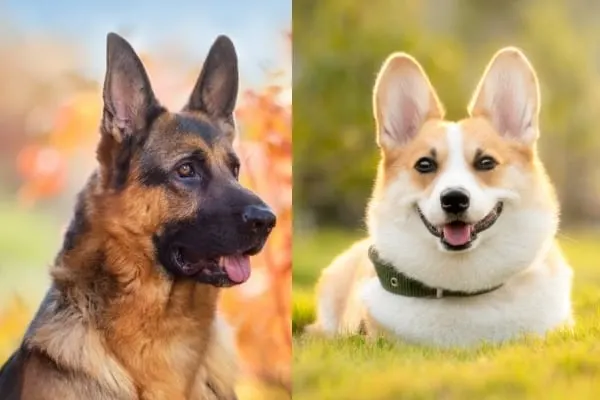
Are Corgi German Shepherd Mixes Good Guard Dogs?
A common misconception is that guard dogs must be ferocious. In actuality, the best guard dogs are discriminating individuals capable of accurately perceiving threats and only biting as a last resort.
The working German Shepherd is one of the best guard dogs, falling in the middle between hyper-aggressive Thuringian ancestors and slow-to-attack Wurttemberg Shepherds.
Welsh Corgis are outgoing, friendly dogs who have a watchful quality against intruders and a sharp bark to warn of trespassers.
Corgis are initially polite with guests but warm up quickly. Since temperament is not always predictable, some Corgis are more protective than others.
Their loyalty makes them protective if they perceive a threat, and they can back up their bark with a sharp bite.
The Cardigan Welsh Corgi is more aggressive than the Pembroke. Temperament became a problem in certain lines of Corgis in, believed to be responsible for a dip in their popularity.
Corman Shepherds are likely to be friendly with your visitors. Hybrids will probably make excellent watchdogs, but you will need to be vigilant in your training to prevent excessive barking.
Your Shepherd Corgi mix will be a somewhat better guard dog than the purebred Corgi but less naturally aggressive and more cordial than most Shepherds.
How Does A German Shepherd Corgi Mix Fit Into Family Life?
What Are The Special Precautions Regarding Children?
German Shepherds usually do well with children of the family as long as they are well-socialized. They look at the household’s occupants as worthy of guarding the same as the family head.
However, as with most large-breed dogs, you should always watch Shepherds closely with toddlers as they may accidentally knock them over. Moreover, Shepherds can pack a serious bite if aggravated.
Corgis once guarded the farmer’s children after a long day of work, according to Canismajor.com.
However, most who are familiar with the breed caution against leaving them unattended with children under five years of age.
Corgis retain a strong herding instinct even if they do not work and are prone to nipping children’s ankles to herd them. Such bites can be painful and can cause falls.
Your Corgi Shepherd mix will need proper socialization to be an appropriately-behaved pet around children.
Since hybrids likely have more substantial weight than a purebred Corgi and may possess strong herding instincts, they make better companions for children over nine years old.
You should exercise vigilant supervision for any young kids, toddlers, and infants.
Can You Have Other Pets Around The Corgi German Shepherd Mix?
German Shepherds and Corgis both seem to prefer to be the only dog in a family. German Shepherds are large, dominant, and dog aggressive.
Corgis are small, but bred to manage cattle, and are not likely to back down from a fight with a mere dog.
A Corgi’s aggressive and belligerent nature makes him vulnerable to serious injury from larger dogs. Shepherds and Corgis have high prey drive concerning small animals.
Your mixed dog may get along fine with dogs and other pets she grows up with. He may react aggressively with strange dogs or cats.
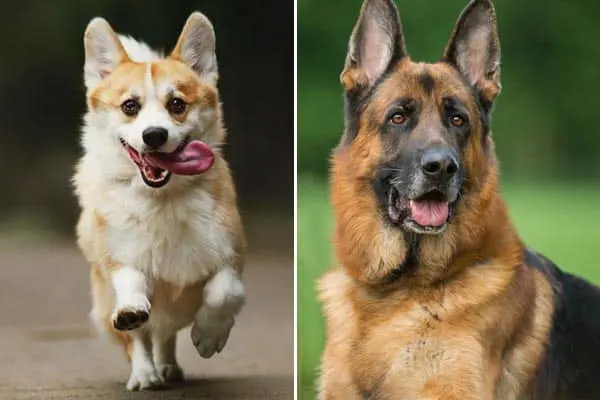
Exercise Requirements
German Shepherds have high levels of energy and need tremendous amounts of exercise. A GSD can easily use two hours of exercise every day, according to PDSA.org.
Ideal exercise programs involve a large portion of daily activities dedicated to mental stimulation and vigorous physical exertion.
Some appropriate exercises are accompanying you on jogs or bicycle rides, consistent training in agility, herding, or Schutzhund, interactive games or toss, and outings like hiking.
Owning a Shepherd requires a level of commitment to being active that many pet owners do not anticipate.
Despite their short legs, Corgis were bred to work long hours, They have a vibrant and lively personality but not quite as much stamina as the German Shepherd.
They can subsist on 45 minutes of exercise daily. Like most herding breeds, Corgis require mental stimulation and periods of rigorous exercise.
Luckily, your German Shepherd Corgi cross will probably fall in the middle between the Shepherd and Corgi in terms of her exercise requirements.
A familiar refrain, she needs some type of mental challenge and a way to exert herself daily.
If you find a dog whose parents come from pet or show lines, the working drive is not so prevalent, and conformation sometimes does not allow for all-out demonstrations of fitness.
Show dogs have lower energy than working lines and can get by with shorter periods of strenuous activities.
Limit exercise intensity and times for developing dogs to help prevent the development of orthopedic problems.
Do Shepherd Corgi Mixes Have Specific Health Problems?
German Shepherds and Corgis are both purebred dogs that have a high probability of passing health issues to their offspring, even crosses.
German Shepherds suffer from genetic diseases like hip and elbow dysplasia, Pannus (eye abnormality affecting the cornea), and epilepsy.
They can also struggle with hemophilia (blood clotting disorder), von Willebrand’s disease (bleeding disorder), pancreatic acinar atrophy (pancreas does not produce digestive enzymes), degenerative myelopathy (progressive neurologic disease), and unexplained seizures.
Corgis suffer similarly from von Willebrand’s disease, hip dysplasia, and degenerative myelopathy as well as intervertebral disc disease secondary to a long back combined with dwarfism and progressive retinal atrophy (leads to blindness).
Hybrids can be healthier than their parents but they may also inherit the same problems.
- Hip and elbow dysplasia
- Bloat – Stomach can fill with fluid and gas and then twist, thanks to a deep chest inherited from the German Shepherd Dog.
- Cataracts
- Progressive retinal atrophy
- Intervertebral disc disease
German Shepherds can live 10 to 12 years while Corgis have a lifespan of 12 to 15 years. Corgi Shepherd crosses typically live 12 to 15 years like their smaller parent.

Grooming Needs
Corgis and German Shepherds both have double coats, meaning they have an outer layer of medium to medium-long hair with an inner lining of shorter, softer, and denser fur.
Both breeds also shed considerably with two major losses of the undercoat twice a year. The outer coat is water-resistant and combined with the undercoat protects the cold and heat.
German Shepherds require brushing every day or two so you can remove soil from the outer coat and control shedding. They do not need baths but every several months.
More frequent hosing them down combined with brushing may help minimize shedding.
Despite the Corgi’s thick double coat, he does not shed as much as the Shepherd. Corgis only need brushing once to three times weekly and baths only two to three times a year.
Like most dogs, Shepherd-Corgi crosses require the use of mild dog shampoo, so their skin does not become dry, flaky, and itchy. Both parent breeds can struggle with allergies, as can the Corman Shepherd.
Allergies can lead to skin and ear infections.
You should clean your dog’s ears every six to eight weeks. Inform your veterinarian of any itchiness, redness, head shaking, discharge, or odor.
Keep an eye on your dog’s nails as well. Your dog will likely have front dewclaws that never touch the ground and therefore need clipping even if the others do not.
An appropriate nail-trimming schedule is once every 6 to 10 weeks.
Your German Shepherd Corgi Mix Should Be Easy To Train
According to Yummy Pet’s quote of Stanley Coren’s ranking of dog breeds by intelligence levels, German Shepherds are in the top 5 percentile at No. 3 while the Pembroke and Cardigan Welsh Corgis scored excellent at No. 11 and No.26, respectively.
Combining intelligent breeds does not necessarily mean the puppies will be smart, but the German Shepherd Corgi mix is very clever. Moreover, she is fairly easy to train.
Corgis have a willingness to please that is somewhat at odds with their independence. However, they pick up new tasks and skills quickly.
German Shepherds are easy to train but can be hard to maintain for a novice.
Any perception of uncertainty or lack of confidence in a handler will invite a German Shepherd to become pushy and overbearing.
The Corgi-Shepherd hybrid, like its parent breeds, requires a self-assured and strong leader. Training must be consistent and firm, and socialization must begin early and be ongoing.
How Much Should You Feed Your Corgi German Shepherd Mix?
Moderately active dogs should eat about 350 to 425 calories per 10 pounds of body weight daily. You should split your Shepherd Corgi mix’s caloric intake into two or three meals over the day.
If your dog seems heavier than he should be, you can work with your veterinarian, but it is generally safe to decrease calories by up to 20% a day.
Higher quality foods such as whole food or raw diets enable you to feed fewer daily calories.
The Corman Shepherd is a dog of manageable size. Note the hybrid’s short legs, but some have even stubbier appendages.
The coloration is like that of a German Shepherd, but you can see Corgi in the face and expression. Ears are upright, and the dog is amiable and loving.
The German Shepherd Corgi mix is often a more friendly and dwarfed version of the purebred GSD.


















